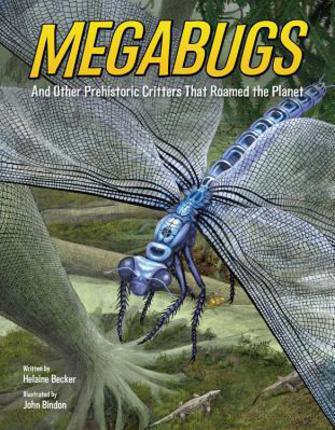
Available now

Can you imagine a bug the size of a small crocodile? How about one bigger than a large basketball player? As scary as it may seem, supersized, insect-like critters such as these roamed Earth long before humans. In this peek into prehistory, award-winning science writer Helaine Becker introduces seven of these megabugs, the ancestors of modern-day insects, spiders, crabs and other arthropods, which lived from 480 million to 47 million years ago. The book explores when, where and how they each lived, why they grew so big and what caused their extinction. Highly realistic illustrations show each megabug in its habitat. The end of the book includes a few supersized critters that are still around today!
This book hits the sweet spot for the many young fans of dinosaurs, prehistoric life and insects of all kinds. Thoroughly reviewed by paleontological experts, the information is presented in an easy-to-digest format for a hi-lo audience (high interest, low reading level). Each spread features one animal and loads of visuals --- such as a size chart that shows how big the animal could grow, a timeline placing it in its geological period and a map of where its fossils have been discovered. Sidebars provide further context on such topics as adaptation, fossils and the Permian Extinction. Detailed illustrations by John Bindon are based on fossil evidence and were created in consultation with experts in the field. This book has terrific STEAM applications in earth science and life science. End matter includes a glossary, resources and an index.
Reviews:
"Writing with crowd-pleasing vivacity—Arthropleura “was bigger than a basketball player. And with up to 80 quick-moving, grasping legs, it could have easily gripped and smothered one too!”—Becker profiles a set of humongous arthropods that, in Bindon’s exactly detailed scenes, crawl, slither, glide, swim, or fly past with all-too-convincing realism. All come with (fossil) range maps and human silhouettes for size comparisons, and most are placed in natural settings, with other fauna of the period visible in the backgrounds. In her descriptive notes, the author maintains a proper caution, following current thinking in suggesting that heightened levels of atmospheric oxygen made such uncommon mass possible but noting that “fave snacks,” life cycles, and causes of extinction are speculations. Following the prehistoric parade, a select set of today’s biggest creepy-crawlies bring up the rear, capped by a menacing science-fictional megabug that looks like an ant-scorpion hybrid." -Kirkus
"“Imagine, deep in the jungle... a swift-moving millipede almost twice your size slithers toward you, snapping its slavering jaws.” B-movie superlatives and natural history museum–diorama aesthetics set the tone for this information-rich exploration of seven Paleozoic arthropods. Bindon’s colorful, detailed illustrations based on “research and fossil evidence” anchor data-laden spreads that show pronunciation and name meaning, habitat, “fave snack,” fossil locations, and the relative size of each creature vis-à-vis a child, among other data points, while Becker’s slangy prose explains what makes each “megabug” special. Inset text boxes identify and concisely explore relevant themes such as oxygen levels and mutation. It’s an appealing way to engage kids fascinated by creepy crawlers. Concisely explains arthropods and eras, and includes a glossary, index, and list of further reading. Ages 8–12." - Publishers Weekly
"'Can you imagine a bug the size of a small crocodile? How about one bigger than a large basketball player? As scary as it may seem, supersized, insect-like critters such as these roamed Earth long before humans. In this peek into prehistory, award-winning science writer Helaine Becker introduces seven of these megabugs, the ancestors of modern-day insects, spiders, crabs and other arthropods, which lived from 480 million to 47 million years ago. The book explores when, where and how they each lived, why they grew so big and what caused their extinction. Highly realistic illustrations show each megabug in its habitat. The end of the book includes a few supersized critters that are still around today!
This book hits the sweet spot for the many young fans of dinosaurs, prehistoric life and insects of all kinds. Thoroughly reviewed by paleontological experts, the information is presented in an easy-to-digest format for a hi-lo audience (high interest, low reading level). Each spread features one animal and loads of visuals — such as a size chart that shows how big the animal could grow, a timeline placing it in its geological period and a map of where its fossils have been discovered. Sidebars provide further context on such topics as adaptation, fossils and the Permian Extinction. Detailed illustrations by John Bindon are based on fossil evidence and were created in consultation with experts in the field. This book has terrific STEAM applications in earth science and life science. End matter includes a glossary, resources and an index." - Maya The Book Explorer
"The author defines arthropod, then places these prehistoric creatures in Earth’s time line, providing important information such as the age of the Earth, the names of the geological eras, and the many periods that comprise an era. Information about how fossils are formed and how rocks can be dated is included. Each megabug has a two-page spread and features a colorful, detailed illustration of the creature and its environs (illustrations were reviewed for accuracy by a trio of paleontologists). Facts such as physical characteristics, when it existed, along with its habitat, diet, how it protected itself, and what potentially caused it to go extinct are mentioned. VERDICT Information is presented clearly and simply in this fascinating (and slightly creepy) exploration of mind-boggling prehistoric megabugs. Recommended for science lovers and casual browsers" - School Library Journal
"Megabugs and Other Prehistoric Critters That Roamed the Planet is rich both visually and factually. Though readers will undoubtedly want to jump right to the creature pages, hopefully they will stop on the “HOW OLD IS EARTH?” spread where Becker provides a timeline which situates the book’s contents in terms of the planet’s history.
Each of the seven megabugs is treated via a two-page spread with one of Bindon’s full-colour illustrations occupying the top two-thirds of both pages. The illustration is separated from the text by a horizontal timeline of the Paleozoic era divided into its six periods with the period in which the creature lived being highlighted.
The text on the left page consistently consists of three parts with the first being a comparison diagram labelled “HOW BIG COULD THEY GROW” in which a silhouette of a 140 cm (4 ft. 7 in.) child is compared to that of the pages’ focal arthropod. And so the diagram involving the Arthropleura, which Becker has nicknamed “The Slitherer”, sees the 260 cm (8 ft. 6 in.) dwarfing the child.
The next text portion is a chart that, in addition to providing a phonetic guide to how to pronounce the arthropod’s scientific name, provides point form information under six headings. ...
More detailed information about the focal arthropod is presented in a two-column format on the right page. Additionally, one large and one small text box is overlaid on Bindon’s illustration. The small one for “The Slitherer” explains that it “may have fed on lycophytes, a type of green plant that was common during the Carboniferous period” while the larger box, containing a graph showing the percentage of oxygen in the atmosphere between 600 and 100 million years ago, illustrates a text point that this creature lived (and grew) during the period when “oxygen levels in the atmosphere had hit an all-time high.”
Becker completes the work with a spread highlighting three “Giants of Today”, the Japanese spider crab, the giant huntsman spider of Australia, and the giant burrowing cockroach, also resident in Australia. End matter includes “A Note on the Illustrations”, a glossary, “Further Reading” and an index.
Fans of dinosaur books may switch allegiance when they encounter Megabugs and Other Prehistoric Critters That Roamed the Planet. A book for all school and public libraries.
Highly Recommended" - CM Magazine
"Rating: 1-5 (5 is an excellent or a Starred review) 5
What did you like about the book? This is an absolutely amazing book but it did leave me a little creeped out–the bugs of the past were huge and scary! Just to say, any child that loves bugs or prehistoric creatures will completely enjoy this book. There are several chapters in this book and each features a different type of megabug on a two-page spread. There is a large illustration of the megabug in their natural habitat, a timeline of when they lived, survival information, and where they lived. The best part is an illustration that features the megabug along side a human child (4’ 7”) to show the size comparison. This part is truly creepy because some of the bugs, the Aegirocassis for example, are almost twice the size of a child. Additional information includes the history of the Earth, giant bugs of today, possible megabugs of the future, a glossary, and an index of further reading.
Anything you did not like about the book. Nothing
To whom would you recommend this book? Perfect for children between the ages of four and ten.
Who should buy this book? Public and elementary school libraries, preschools, daycare centers, anyone that works with children between the ages of four and ten.
Where would you shelve it? 567.9 or 595.7
Should we (librarians) put this on the top of our “to read” piles? Yes." - YS Book Reviews
978-1771388115 Kids Can Press/Hachette
Hardcover $19.95 CN/ $17.95 US
